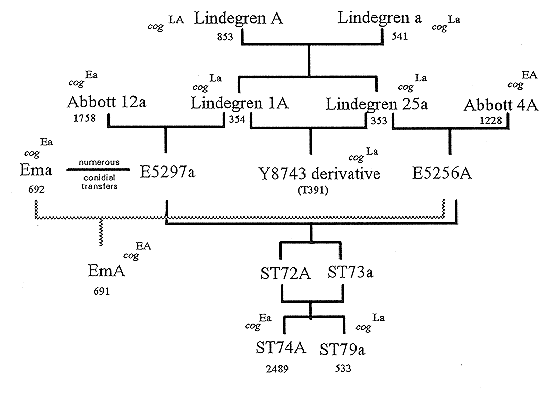
The legitimacy of classic wild-type strains deposited in the FGSC has been assessed by examining polymorphisms (Newmeyer et al. 1987 Neurospora Newsl. 34:46-51; Catcheside, D.G. 1975 Aust J Biol Sci 28:213-225). These studies show that Lindegren a (FGSC 541), Lindegren 1A (FGSC 354), Abbott 12a (FGSC 1758) and St Lawrence 79a (FGSC 533) are probably not authentic. We have examined the cog-region (distal of histidine-3 on Linkage Group I) in a number of strains and found four different RFLP variants, a different one in each of the alleged progenitor stocks of the modern laboratory strains (Yeadon and Catcheside, 1995. Curr. Genet., in press). The pedigree diagram (based on Catcheside 1975 and Newmeyer et al. 1987) shows the cog-region variant present in each of the strains we examined. Our nomenclature for cog alleles reflects the first strain in which it was found, for example cogEa in Ema. FGSC stock numbers are shown below the strain name. T391, our laboratory stock number, contains his-3 K26, a mutant generated (Angel et al. 1970. Aust J Biol Sci 23:1229-1240) in Lindegren Y8743 (Barratt and Garnjobst, 1949. Genetics 34:351-369).
Our data confirm the conclusion based on rec-3 genotype (Catcheside, D.G. 1975) that FGSC 533 is not an authentic ST79a stock as it has a cog-region apparently inherited from Lindegren 25a (FGSC 353) although supposedly descended from Emerson strains, both of which have cog-regions derived from the Abbott strains. The other suspect strains listed above have cog-region alleles compatible with the pedigree. Although the FGSC stocks for Lindegren a (541) and Abbott 12a (1758) are doubtful, the simplest interpretation of our data is that each has the cog-region allele present in the genuine strain and is at least a descendant of the strain it is purported to be.
